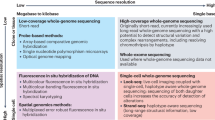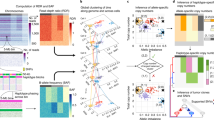Abstract
Human cancers and some congenital traits are characterized by cytogenetic aberrations including translocations, amplifications, duplications or deletions that can involve gain or loss of genetic material. We have developed a simple method to precisely delineate such regions with known or cryptic genomic alterations. Molecular copy-number counting (MCC) uses PCR to interrogate miniscule amounts of genomic DNA and allows progressive delineation of DNA content to within a few hundred base pairs of a genomic alteration. As an example, we have located the junctions of a recurrent nonreciprocal translocation between chromosomes 3 and 5 in human renal cell carcinoma, facilitating cloning of the breakpoint without recourse to genomic libraries. The analysis also revealed additional cryptic chromosomal changes close to the translocation junction. MCC is a fast and flexible method for characterizing a wide range of chromosomal aberrations.
*Note: Correspondence should be addressed to M. Thangavelu (mt370@hutchison-mrc.cam.ac.uk) instead of T. H. Rabbitts. The error has been corrected in the PDF version of the article.
This is a preview of subscription content, access via your institution
Access options
Subscribe to this journal
Receive 12 print issues and online access
$259.00 per year
only $21.58 per issue
Buy this article
- Purchase on Springer Link
- Instant access to full article PDF
Prices may be subject to local taxes which are calculated during checkout






Similar content being viewed by others
Change history
08 June 2006
Correspondence should be addressed to M. Thangavelu (mt370@hutchison-mrc.cam.ac.uk) instead of T. H. Rabbitts. The error has been corrected in the PDF version of the article.
References
Albertson, D.G., Collins, C., McCormick, F. & Gray, J.W. Chromosome aberrations in solid tumors. Nat. Genet. 34, 369–376 (2003).
Rabbitts, T.H. Chromosomal translocations in human cancer. Nature 372, 143–149 (1994).
Kovacs, G., Szucs, S., De Riese, W. & Baumgartel, H. Specific chromosome aberration in human renal cell carcinoma. Int. J. Cancer 40, 171–178 (1987).
Kovacs, G. & Brusa, P. Recurrent genomic rearrangements are not at the fragile sites on chromosomes 3 and 5 in human renal cell carcinomas. Hum. Genet. 80, 99–101 (1988).
Kovacs, G. et al. The Heidelberg classification of renal cell tumours. J. Pathol. 183, 131–133 (1997).
Pinkel, D. & Albertson, D.G. Comparative genomic hybridization. Annu. Rev. Genomics Hum. Genet. 6, 331–354 (2005).
Fiegler, H. et al. DNA microarrays for comparative genomic hybridization based on DOP-PCR amplification of BAC and PAC clones. Genes Chromosom. Cancer 36, 361–374 (2003).
Menten, B. et al. arrayCGHbase: an analysis platform for comparative genomic hybridization microarrays. BMC Bioinformatics 6, 124 (2005).
Brennan, C. et al. High-resolution global profiling of genomic alterations with long oligonucleotide microarray. Cancer Res. 64, 4744–4748 (2004).
Carvalho, B., Ouwerkerk, E., Meijer, G.A. & Ylstra, B. High resolution microarray comparative genomic hybridisation analysis using spotted oligonucleotides. J. Clin. Pathol. 57, 644–646 (2004).
Lucito, R. et al. Representational oligonucleotide microarray analysis: a high-resolution method to detect genome copy number variation. Genome Res. 13, 2291–2305 (2003).
Sebat, J. et al. Large-scale copy number polymorphism in the human genome. Science 305, 525–528 (2004).
Jobanputra, V. et al. Application of ROMA (representational oligonucleotide microarray analysis) to patients with cytogenetic rearrangements. Genet. Med. 7, 111–118 (2005).
Zhou, W. et al. Counting alleles reveals a connection between chromosome 18q loss and vascular invasion. Nat. Biotechnol. 19, 78–81 (2001).
Zhao, X. et al. Homozygous deletions and chromosome amplifications in human lung carcinomas revealed by single nucleotide polymorphism array analysis. Cancer Res. 65, 5561–5570 (2005).
Dear, P.H. & Cook, P.R. Happy mapping: a proposal for linkage mapping the human genome. Nucleic Acids Res. 17, 6795–6807 (1989).
Eichinger, L. et al. The genome of the social amoeba Dictyostelium discoideum. Nature 435, 43–57 (2005).
Ebert, T., Bander, N.H., Finstad, C.L., Ramsawak, R.D. & Old, L.J. Establishment and characterisation of human renal cancer and normal kidney cell lines. Cancer Res. 50, 5531–5536 (1990).
Daruwala, R.S. et al. A versatile statistical analysis algorithm to detect genome copy number variation. Proc. Natl. Acad. Sci. USA 101, 16292–16297 (2004).
Cohen, H.T. & McGovern, F.J. Renal-cell carcinoma. N. Engl. J. Med. 353, 2477–2490 (2005).
Acknowledgements
This work was supported by the Medical Research Council. G.C. was partly supported by the Kay Kendall Leukemia Fund. We thank L. Old for generously supplying the renal cell line SK-RC-9 and N. Copeland for providing an inverse PCR protocol.
Author information
Authors and Affiliations
Contributions
A.D., M.T., R.P., A.F. and G.C. conducted the experimental procedures; A.D., M.T., P.H.D. and T.H.R. devised the project; A.D., P.H.D. and T.H.R. wrote the manuscript.
Corresponding author
Ethics declarations
Competing interests
The authors declare no competing financial interests.
Supplementary information
Supplementary Fig. 1
Painting of SK-RC-9 metaphase chromosomes. (PDF 81 kb)
Supplementary Fig. 2
Identification of micro-deletion in SK-RC-9 chromosome t(3;5). (PDF 33 kb)
Supplementary Fig. 3
Agarose gel fractionation of PCR products for round one MCC of SK-RC-12 DNA. (PDF 99 kb)
Supplementary Fig. 4
Filter hybridization of SK-RC-12 DNA to confirm genomic alteration detected by MCC. (PDF 66 kb)
Rights and permissions
About this article
Cite this article
Daser, A., Thangavelu, M., Pannell, R. et al. Interrogation of genomes by molecular copy-number counting (MCC). Nat Methods 3, 447–453 (2006). https://doi.org/10.1038/nmeth880
Received:
Accepted:
Published:
Issue Date:
DOI: https://doi.org/10.1038/nmeth880
This article is cited by
-
Copy number variation related disease genes
Quantitative Biology (2018)
-
Insights into the genome structure and copy-number variation of Eimeria tenella
BMC Genomics (2012)
-
Disruption of ETV6 in intron 2 results in upregulatory and insertional events in childhood acute lymphoblastic leukaemia
Leukemia (2008)



